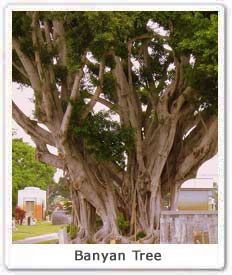| Kingdom : | Plantae |
| Division | Magnoliophyta |
| Class: | Magnoliopsida |
| Order : | Urticales |
| Family : | Moraceae |
| Genus : | Ficus |
| Zoological name : | Ficus Benghalensis |
| Found In : | Ranthambore National Park and Corbett National Park |
Other names : Bargad, Bor, Ber, Ala and Pedda mari, Nayagrodha, Ala mara, Bar, Vad, Vatnam, Bahupada, Peddamarri, Al are the other names used for the Banyan tree. Indians call it a wish fulfilling tree.
Description : Banyan tree is a huge tree with very extensive branches. It is said that at one time more than 10, 000 people can sit under its shade at one time. It is a evergreen tree. It branches spread out and send trunk like roots to the ground in order to support itself. It grows to a height of more than
 21
meters and lives for many years. The leaves are 10 -20 cm long and has many
aerial roots. The leaves are broad, oval and glossy. White milky fluid oozes
out of leaves, if broken. It can grow in to the gaint tree covering several
hectares.
21
meters and lives for many years. The leaves are 10 -20 cm long and has many
aerial roots. The leaves are broad, oval and glossy. White milky fluid oozes
out of leaves, if broken. It can grow in to the gaint tree covering several
hectares. Other Species : F. aurea, F. benghalensis, F. citrifolia, F. macrophylla, F. microcarpa, F.pertusa, F. rubiginosa are the other related species of the Banyan tree.
Location : Found in almost all the parts of India, Banyan tree is the National tree of India. It is grown throughout the sub- Himalayan region and in the deciduous forests. One can Banyan Tree in the Botanical Garden of Calcutta. They are widely grown in the Ranthambore National Park and Corbett National Park in India.
Cultivation methods :Banyan tree is easily propagated by root tip cuttings or the eye cuttings. Cut apiece of the stem about half a inch below and above the leaf. Insert the stem piece and a little of the leaf stalk into the rooting medium. To reduce evaporation from the leaf surface, you can roll the leaf and secure with a rubber band. In a couple weeks roots and a new shoot will start developing. It can grow in any type of soil.
Medicinal uses : The Banyan tree also has several medicinal properties. Its leaf, bark, seeds and fig are used for the variety of disorders like diarrhea, polyuria, dental, diabetes and urine disorders. The wood of the Banyan tree is used in making door panels, boxes and the other items. Its bark is used for making paper and ropes. The milky latex that comes from its leaves and stems is used in many Ayurvedic medicines.
Other uses : In India its edible leaves are used as the plates. It is planted for the soil conservation. Wood is used for well curbs, door panels, boxes, furniture etc. It is suitable for paper pulp. The wood of the aerial roots is stronger and is used for the tent poles and cart yokes.
Cultural importance : Banyan tree is respected and is considered as sacred by the people in India. In the sacred Hindu Book 'Bhagwad Gita' Lord Krishna has sung praises on the Banyan tree. People in India grow Banyan tree closer to the Peepal tree. As Banyan tree is considered as the male plant closely related to the Peepal tree. It symbolize Trimurti with Vishnu as the barl, Shiva as the branches and Brahma as the roots. Indians considered Banyan tree as 'Kalpa Vriksha' the tree that fulfill all your wishes.The mighty Banyan Tree is considered as immortal and has always been the focal point for the village communities in India. It is probably the biggest and friendliest of all trees. Banyan tree is the tree of knowledge and tree of life.






